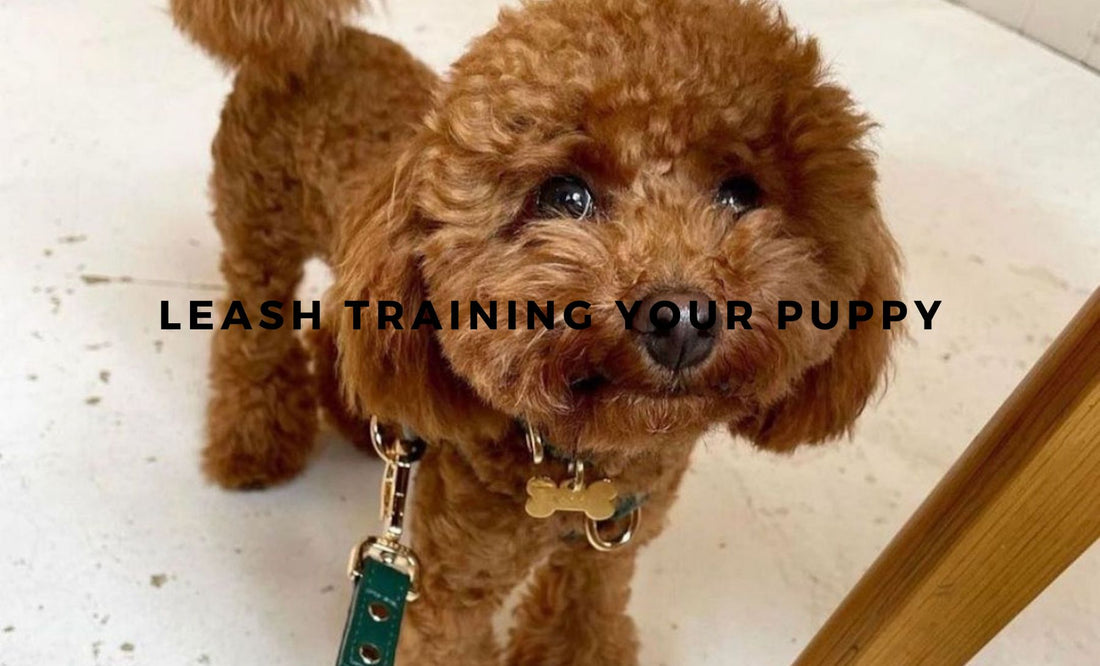
1.0 Start Slowly
When introducing your puppy to a lead, start slowly. Begin by allowing your pup to explore and get comfortable with the leash by wearing it around the house or in the backyard without tension on the leash. Allow your pup to get used to the weight of the leash, the sound it makes, and the pressure on their collar. A really great first step to introducing your dog to leash training is to simply have the lead out for your puppy to get used to. Simply leave it on the floor or a table near your puppy so he or she gets used to seeing it and smelling it. But be careful he or she doesn't chew it!
 Make sure to introduce your dog to their leash with care and encouragement! Making the leash a positive experience, will making training much easier.
Make sure to introduce your dog to their leash with care and encouragement! Making the leash a positive experience, will making training much easier.
2.0 Choose the Right Equipment
Make sure you have the right equipment before beginning leash training. A well-fitting collar or harness and a leash that is the appropriate length and width will make a big difference in your dog's comfort and safety. Choose a collar or harness that fits snugly but is not too tight or too loose. Check out our collar and harness size guide, to see how our products fit on your pooch! Select a leash that is not too long (especially when training your dog in high-traffic areas) and not too heavy as to put your dog off. The ST ARGO leash is an ideal lead to train a puppy as it is 130 centimetres long, wide enough to provide great support to the handler, but made with lightweight vegan leather so as not to overbear your pup. Check out our range of dog leads today.
 ST ARGO leads are the perfect tool for puppy training due to their weight and dimensions. PLUS, they have a heavy duty safety clasp for added security.
ST ARGO leads are the perfect tool for puppy training due to their weight and dimensions. PLUS, they have a heavy duty safety clasp for added security.
3.0 Use Positive Reinforcement
Positive reinforcement is essential for leash training. Always bring treats with you to reward your dog's good behaviour, and use praise and affection as a way to motivate your puppy. We talk more about positive reinforcement in dog training in this blog. When your puppy is walking calmly and without pulling on the leash, reward them with a treat or praise. Over time, your pup will associate the behaviour with rewards and will repeat the behaviour.

4.0 Start Indoors
It's a good idea to start leash training indoors before moving outside. This will help your puppy get used to the concept of walking on a leash without the distractions of outdoor smells and sounds. It is also a much safer option. Encourage your puppy to walk beside you, and reward them for staying close and walking at a calm pace. Baby steps.
Positive reinforcement is vital when training your puppy how to behave when leashed.
5.0 Be Patient
Leash training takes time and patience. Remember that your puppy is learning a new skill, and they won't get it right every time. If your puppy starts to pull on the leash, stop walking and stand still until they calm down. They will eventually learn to associate pulling with stopping, and this will discourage them from pulling in the future.
6.0 Gradually Increase Distance
Gradually increase the distance you walk with your puppy on the leash. Start with short walks around your yard or block, and gradually increase the distance as your puppy gets more comfortable with walking on a leash. Don't rush the process, and always pay attention to your puppy's energy levels and behaviour.
 This cute golden cocker spaniel learns the ropes and starts to build confidence walking in her ST ARGO Lilac lead!
This cute golden cocker spaniel learns the ropes and starts to build confidence walking in her ST ARGO Lilac lead!
7.0 Use a Distracting Toy
Another way to keep your puppy's focus on you during leash training is to carry a toy. A toy can distract your puppy and keep them engaged while you work on leash training. However, be sure to choose a toy that is easy to carry and won't distract your puppy too much.
8.0 Don't Use Retractable Leashes
Avoid using retractable leashes during leash training. Retractable leashes can be unpredictable and may not give you the control you need to keep your puppy safe. A standard leash, such as the ST ARGO lead, will give you better control and will allow you to guide your puppy more effectively.
So, leash training your puppy takes time and patience, but it's an essential part of raising a well-behaved dog. By starting slowly, using positive reinforcement, and gradually increasing the distance, you can successfully leash train your puppy. Remember to be patient, stay consistent and reward good behaviour, and before you know it, your pup will be walking like a pro.

Shop for your best walk yet with us. Harness Walk Sets are a great start!

